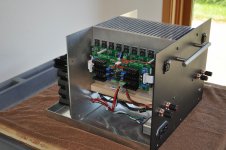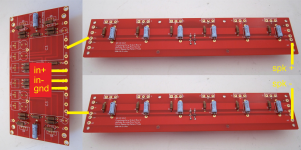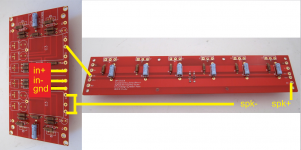In the XA.8 single-ended current sources thread http://www.diyaudio.com/forums/pass...gle-ended-current-sources-37.html#post4347792 I posted simple way to experiment with constant current sources with existing balanced amplifier PCBs by mounting two tiny CCS PCBs on your output stage heatsink and attaching 4 wires to output phases and rails.
If you need to unbalance the 2nd harmonic from the output stage, you will need to disable the gate drive one FET in "appropriate" quadrants, which involves attaching the gate pin to the source pin instead of the gate-stopper attached to the front-end gate drive trace.
If you need to unbalance the 2nd harmonic from the output stage, you will need to disable the gate drive one FET in "appropriate" quadrants, which involves attaching the gate pin to the source pin instead of the gate-stopper attached to the front-end gate drive trace.
Let's see if I have a grasp on this.....
OK, I have a BA-3 power amp in a 5U case. This amp is a stereo amp, and has a single power supply and power transformer.
So, If I wish to have BBA-3 Mono blocks, I just duplicate what I have, i.e. another BA-3 in another 5U box, just like I have.
Then, arrange the R5 thing to convert both these amps to BBA-3 Monoblocks?
If I am correct as far as the amps are concerned, then I assume there will of course be changes in the way the inputs and outputs are wired...but before going there just want to make sure the conversion of a stereo BA-3 to a (single) Mono block BBA-3 is as simple as this? Once I have that assurance I will get the rest of the parts for another amp like I have and then figure out XLR input wiring and those changes.
Ok, let me have it if I have grossly mis-stated anything here. Any patience here much appreciated!
Russellc
OK, I have a BA-3 power amp in a 5U case. This amp is a stereo amp, and has a single power supply and power transformer.
So, If I wish to have BBA-3 Mono blocks, I just duplicate what I have, i.e. another BA-3 in another 5U box, just like I have.
Then, arrange the R5 thing to convert both these amps to BBA-3 Monoblocks?
If I am correct as far as the amps are concerned, then I assume there will of course be changes in the way the inputs and outputs are wired...but before going there just want to make sure the conversion of a stereo BA-3 to a (single) Mono block BBA-3 is as simple as this? Once I have that assurance I will get the rest of the parts for another amp like I have and then figure out XLR input wiring and those changes.
Ok, let me have it if I have grossly mis-stated anything here. Any patience here much appreciated!
Russellc
Yes, what you say about the ba-3 balanced is correct. Change just a bit of wiring and the stereo amp turns into a monoblock. Duplicate it for stereo.
Also, you don't need to worry about XLR input ( if you don't have a balanced preamp...) it will still work with single -ended input, just attach the -in to ground. Of course, you can wire it for both.

Also, you don't need to worry about XLR input ( if you don't have a balanced preamp...) it will still work with single -ended input, just attach the -in to ground. Of course, you can wire it for both.
OK, I have a BA-3 power amp in a 5U case. This amp is a stereo amp, and has a single power supply and power transformer.
So, If I wish to have BBA-3 Mono blocks, I just duplicate what I have, i.e. another BA-3 in another 5U box, just like I have.
Then, arrange the R5 thing to convert both these amps to BBA-3 Monoblocks?
If I am correct as far as the amps are concerned, then I assume there will of course be changes in the way the inputs and outputs are wired...but before going there just want to make sure the conversion of a stereo BA-3 to a (single) Mono block BBA-3 is as simple as this? Once I have that assurance I will get the rest of the parts for another amp like I have and then figure out XLR input wiring and those changes.
Ok, let me have it if I have grossly mis-stated anything here. Any patience here much appreciated!
Russellc
Received info that indeed, this is all that's needed for the basic conversion of a stereo BA-3 to a Mono block BBA-3, not including the input output changes. (Thanks 6L6, who was away from computer but thoughtful enough to contact me via cell.) I want to replace the "extra" RCA jack with a XLR....I do have a Pumpkin-Shunty to build one of these days!
Russellc
Certainly this is one the fugliest one what I ever seen: 
http://www.diyaudio.com/forums/pass-labs/216086-new-bba3.html
http://www.diyaudio.com/forums/pass-labs/216086-new-bba3.html
Another question. My plan is to build BBA-3 in 5U chassis, two of them, as mono blocks. my question concerns fireup. First, do both out put boards retain their own bias board?
Secondly, what is bias protocol on this? I assume that as with standard BA-3 the front ends are biased and offset set. I of course saw how the interaction was between pots in the unbalanced version, but now, with two "sides" per mono block I am confused. Now, once front end is set, (however that is accomplished) do you just (and it seems to me it must be?) go back and forth between both output boards bias boards? I dont understand how you could set one half of the BBA-3 monoblock and maintain the zero'd offset? Or do you set the bias on one "side," then the other, and then go back and forth between the halves with pots that controls offset until offset is good? I just cant see it in my head how to do this, of course if one bias board controls both halves I do, but I really dont see how that would work either.
Russellc
Secondly, what is bias protocol on this? I assume that as with standard BA-3 the front ends are biased and offset set. I of course saw how the interaction was between pots in the unbalanced version, but now, with two "sides" per mono block I am confused. Now, once front end is set, (however that is accomplished) do you just (and it seems to me it must be?) go back and forth between both output boards bias boards? I dont understand how you could set one half of the BBA-3 monoblock and maintain the zero'd offset? Or do you set the bias on one "side," then the other, and then go back and forth between the halves with pots that controls offset until offset is good? I just cant see it in my head how to do this, of course if one bias board controls both halves I do, but I really dont see how that would work either.
Russellc
Yes, both output sections need their bias boards. They won't bias without it. So for a monoblock, there will be one front-end and two output sections w/bias boards.
Bias is straightforward - set the bias of the front-end just like a F5. Once that's set, you don't have to worry about it again. Then set the bias of each output section, with it's own bias pot, and own offset pot. Because this is not a DC-coupled design, each section will set individually from the others.
Global DC offset will be bias balance between the two halfs (Phases). It will make more sense when you are doing it.
Bias is straightforward - set the bias of the front-end just like a F5. Once that's set, you don't have to worry about it again. Then set the bias of each output section, with it's own bias pot, and own offset pot. Because this is not a DC-coupled design, each section will set individually from the others.
Global DC offset will be bias balance between the two halfs (Phases). It will make more sense when you are doing it.
Then set the bias of each output section, with it's own bias pot, and own offset pot. Because this is not a DC-coupled design, each section will set individually from the others.
That makes it easier to understand. Thanks, I am sure I will ask for last min. clarity before fireup, I just want to know what to expect before I flip the switch.
Russellc
A question about heatsink temperature
I have built an amplifier with a power dissipation well over 300 Watts using heatsinks mounted fin-to-fin which allows the option of fan cooling. See the photo below. I have 3 options for cooling.
I have built an amplifier with a power dissipation well over 300 Watts using heatsinks mounted fin-to-fin which allows the option of fan cooling. See the photo below. I have 3 options for cooling.
- Natural convection: stabilizes at about 60C, 35C above ambient.
- Noctua 120mm fans at 600RPM using series resistors, the slowest reliable speed without stalling, stabilizes at about 42C, 17C above ambient.
- Noctua 120mm fans with PWM control at lower speeds to obtain 50C, 25C above ambient.
Attachments
a fan using a resistor (= high source impedance) is liable to stalling at start up. This is especially a problem after a few years/months as the lubrication becomes thick.
Pass posted a fan motor PSU that gives the motor a starting kick and then drops to running voltage.
PWM control may give a problem with interference, but otherwise is a good solution.
Pass posted a fan motor PSU that gives the motor a starting kick and then drops to running voltage.
PWM control may give a problem with interference, but otherwise is a good solution.
It has been almost one year since I built two BA-3b monoblocks for my Maggies, and I love them. Soundstage gets bigger and bigger, without any sign of distortion: incredible.
I have however two questions.
Right now, I feel that the overall gain (I use a B1 as buffer/volume control; for now I'm using it as unbalanced) is a bit too low. Many times the volume pot is past 3. I could increase the gain by playing with R10 and R13... but I'm not sure if this will force me to re-check the bias and offset of the front-end. And being it balanced, I'm afraid it will be a mess to check!
This brings me also to the next question. I'm planning to use a computer based distortion analyzer and oscilloscope, in order to play with P3. Does this also influence the bias and the offset?
What is therefore the best way to perform these modifications without going crazy with the pots setting? I also remember that bias and offset were highly dependent on temperature (closed/open lid)... I'm a bit worried
Thank you for the help!
Giulio
I have however two questions.
Right now, I feel that the overall gain (I use a B1 as buffer/volume control; for now I'm using it as unbalanced) is a bit too low. Many times the volume pot is past 3. I could increase the gain by playing with R10 and R13... but I'm not sure if this will force me to re-check the bias and offset of the front-end. And being it balanced, I'm afraid it will be a mess to check!
This brings me also to the next question. I'm planning to use a computer based distortion analyzer and oscilloscope, in order to play with P3. Does this also influence the bias and the offset?
What is therefore the best way to perform these modifications without going crazy with the pots setting? I also remember that bias and offset were highly dependent on temperature (closed/open lid)... I'm a bit worried
Thank you for the help!
Giulio
what does this mean?Many times the volume pot is past 3.
A vol pot usually has ~270degrees of electrical rotation and ~300degrees of mechanical rotation.
What does "past 3" mean?
what does this mean?
A vol pot usually has ~270degrees of electrical rotation and ~300degrees of mechanical rotation.
What does "past 3" mean?
I meant the 3 o'clock position, which is ~240° of mechanical rotation if the knob is mounted to the pot in a reasonable way. Is there a better way to say it in English?
Last edited:
- Home
- Amplifiers
- Pass Labs
- Burning Amp BA-3b (Balanced)


